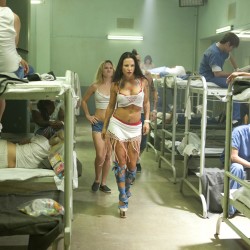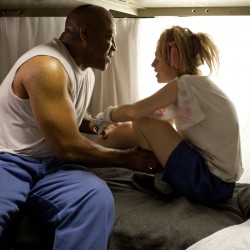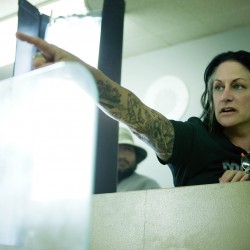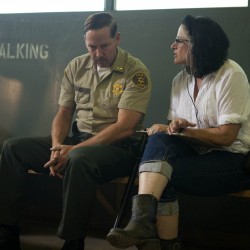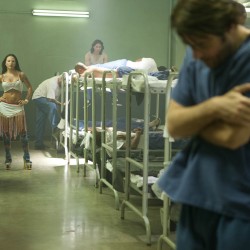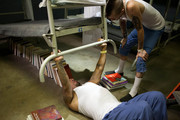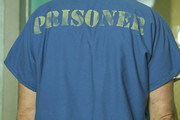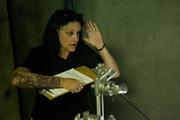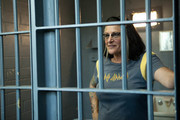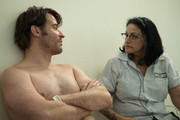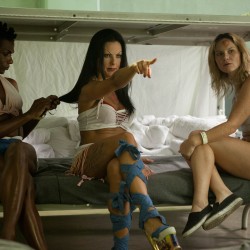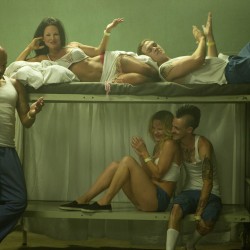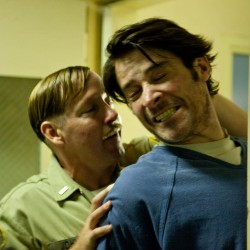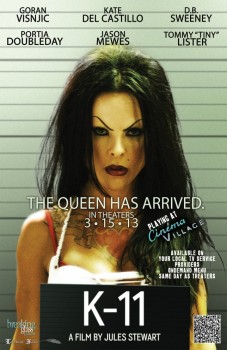Jules Stewart is the mother of a certain Twilight star, but to even mention that almost does a disservice to her latest project, which is an edgy and challenging example of independent filmmaking at its finest. Having spent three decades working in Hollywood as a script supervisor, with a résumé that spans 30 films and over 50 TV shows, Stewart knows a thing or two about what makes a good story and how to avoid the grind of tired and traditional screenwriting formulas. Consequently, K-11, which she co-wrote with Jared Kurt, is a compelling and very unique take on the prison drama. The highly accomplished film, which features an extraordinary ensemble cast, also marks Stewart’s directorial debut.
Nicole Powers: The penal system in America is of great interest to me. Why did you choose to write a film based in a jail?
Jules Stewart: Well, it’s not just based in any jail. First of all, K-11 is a real place and it only exists in LA. It’s a part of the jail system here in Los Angeles that not too many people know even exists. So right there it’s fascinating to me. How could this have been here since the ‘50s and nobody know? I think that it’s a whole different take on the jail movie.
NP: How did you first become aware that K-11 existed?
JS: I was on a television pilot, and one of the guys that was working on the pilot as well came to me and said, “I have this idea, I want to make a script about K-11 and I thought maybe you would write it with me.” So I did some research and found out what it was and I thought, this is so unique, it’s so original, nobody’s ever done it before.
NP: So what exactly is K-11?
JS: K-11 is a specific dorm in Los Angeles Men’s County Jail that houses the gay and transgender inmates. It’s the only place in the jail system where race is not an issue, because everybody in there, the common thread is that they’re gay or transgender.
NP:Did you visit the jail when you were doing research for the script?
JS:Of course.
NP:Are some of the characters based on people you met there?
JS: Not at all. What we did was we took the actual schedule of the dorm, the actual routine, and we invented characters and we put them in the system.
NP: In your story the main character, Raymond, is very straight. Why did you choose to put the cat among the pigeons?
JS: Because it’s more interesting that way isn’t it. He’s a fish out of water. He clearly doesn’t belong there. But he got railroaded in there because he’s got money and he’s obviously into drugs. Money and drugs, that’s what runs the system.
NP: The story is set against a background of massive corruption, where those in charge are either actively involved or complicit because they’re actively looking the other way…
JS: Let me stop you right there. We made it all up. If you look at the history of jail films, jail TV shows, it’s the conflict that makes the story interesting, so it’s always about the corruption. It’s always about corruption, it’s always about conflict, it’s always about me versus you, otherwise there’s no story. So clearly we made up the corruption, we made up the whole conflict within our own little story with our own little made up characters. But the dorm itself does exist, it is a real place, and that was our foundation.
NP: So how much is reality? For example, in the movie the ladies and gentleman of K-11 have quite a lot of latitude with their uniform.
JS: That’s true. That part of it is true. The inmates are allowed to customize their jail wear, but they’re not allowed to wear it in the hallways or any what they call public places. They’re only allowed to wear it in their dorm. And they can only do it if they have another set of blues to put on when they do go outside…Otherwise they’re allowed to do whatever they want within their own confines in terms of their wardrobe.
NP: So the choice to portray the corruption came purely from the desire to tell a compelling story rather than any political point of view?
JS: It’s purely story. I like to consider myself, and I’m sure [co-writer] Jared [Kurt] does too, we’re storytellers. I’m not a political activist. I never went out and made any kind of political statements or anything. It’s all about telling a story.
NP: You have an incredibly impressive résumé as a script supervisor; you’ve studied the art of the story in a way that most people haven’t in Hollywood.
JS: I love a great story, and a great story has a couple of different elements. It has conflict and it has maybe sometimes some romance, it’s got to have that human element that people can relate to.
NP: What motivated you to make the leap now from script supervisor to telling your own stories?
JS: It’s a natural thing isn’t it? At some point you want to tell your own stories. And I was in a position where I had a script and people were willing to give me money to make it, so I thought why not?
NP: Well, you did a great job. Not only is the story great, but so are the choices you made as a director, and the acting is incredible. I have one question though: Why did you choose to have women play the transgender roles?
JS: That’s a good question. Because it’s my opinion that when you’re talking to someone who considers themselves transgender, you’re actually talking to a man who is a woman. Out of respect you have to think of them also as a woman – because that’s how they think of themselves.
Mousey clearly when she’s in the dorm, she doesn’t think of herself as a man. She clearly thinks of herself as a woman. And I thought it would be more interesting to cast a woman playing a man turning into a woman. It really gives you food for thought, doesn’t it?
NP: And it helped with that whole Alice In Wonderland aspect that you bring to it, where our protagonist lands down a rabbit hole and has to figure out where he is.
JS: Exactly, exactly. And what you see is not necessarily what you get…It’s traveling down the rabbit hole into an unknown world.
NP: Where was it shot?
JS: It was shot in Civil Brand, which is a Los Angeles Country Women’s Jail that is now closed down, but the floor plan and the structure and the colors and everything mirror Men’s County Jail so it was a genius location for us.
NP: Also, the saturated colors you use give it a hyper-reality.
JS: A little bit. In the dorm there’s no windows, there’s no clocks, and you have that very stark overhead lighting which causes demonic shadows and things like that on people, so it was absolutely by choice that we designed it to look that way. It’s also quite green, which is not necessarily very flattering for most people.
NP: With the American legal system increasingly becoming a minefield it’s estimated that the average person breaks the law inadvertently multiple times a day. So this idea that one day you could wake up and find yourself in a jail is actually kind of a reality for all of us, so this movie is very much a universal nightmare.
JS: I think so. Also getting lost in the system. I mean, quite frankly, he has no idea where he is. Because when he first gets put into K-11 and he’s walking around he’s not sure who he’s looking at. There are some men in there, but there are clearly some women in there was well, and I wanted to lead people to think that he believed that maybe he was in a mental institution. He even says, “I’m in some kind of institution, you have to get me out of here” when he’s desperately trying to make those phone calls. And that trying to make the phone call and you can’t get through, the line’s busy and no one answers or someone hangs up on you, that’s that frustration that just keeps building and building. That was real important for Raymond’s character.
NP: Watching him, it’s like watching a rat in a maze. Even getting a simple thing like a shower, getting to the top of the queue but still not being able to take one, he has to figure out whose hand to grease, which proverbial lever to pull to get the reward.
JS: Well, human beings are run by their little routines. Every location, every place where you go – especially if it’s an institution or if it’s city or county run – there’s a routine, and until you know what the routine is it’s very difficult to get anything done. That’s mostly part of his problem, that he has no idea what the routine is. He has no idea where he is, he has no idea what the rules are, he has no idea what’s going on. All he sees is the telephone on the wall. That’s the way out for him, the telephone, and he can’t ever get through so it’s pretty frustrating.
NP: The beauty of this movie is that you’re in Raymond’s head and you’re figuring things out with him, and he’s such a compelling character. What’s the process for you when you’re creating a character?
JS: I think the first step is that you have to figure out who’s telling the story. Who’s point of view is this story being told from? Is it a third person? Or is it first person? Or is it second person? Who is it? In our case we felt it would be more interesting to tell the story from Raymond’s point of view. That being said, the film takes sort of a left turn. Because you try to learn things as he learns things…and that keeps it going. I think if the audience knows more than the main character then the story has a tendency to become a bit boring. So it was a fine line; how much do we reveal without Raymond finding out first.
NP: Considering you’ve spent most of your career as a script supervisor in Hollywood, which is a very formulaic town, this is a surprisingly non-formulaic story.
JS: I’ve been very lucky in my career, I’ve had a chance to work with some people that I feel are genius storytellers – David Lynch being one. If you look at things as a moment in time, and things reveal themselves as the character finds out about what’s going on, it makes things more interesting. Not everything in life is very linear. Some things are a little out of order. Like when you remember things, sometimes you remember the most recent things first and you work your way backwards…We just told the story the way we thought we should tell it.
NP:And you were being very honest to the characters.
JS: And we were being honest, yes. I mean, I will give you that; we stole characteristics from people, but people in our lives not people in the jail. You build characters based on what you know. My son’s character for instance, Sledgehammer, I always thought it would be Cameron who would play that. I was hoping he would agree to do it since he’s never done it before. I took things out of his own personality and out of his own behavioral patterns and put them into the character, which made it really easy for him because things came naturally.
NP: It was Cameron’s acting debut?
JS:Yes.
NP: Wow, he did a great job. The whole cast did an amazing job.
JS: Casting…It’s 99 and 9/10s of the movie. For years as a script girl I would watch the stand-ins rehearse scenes and then watch the actors come in and do them, and it was the same scene but completely different. I really had a chance to see first hand the difference that each character brings to the set and to the film. It’s amazing, if you change one character you change the movie…And the people that we actually ended up hiring, one of the biggest criteria was they couldn’t be afraid of the material. They had to embrace the material and get into it and more. And they all did. I would love to see them get some recognition in the community for their talents because it’s amazing to me the job that these people did…
One of the most definitive things about K-11 and I think it shows on the film is that we had fun making the movie. Every one who was in the movie enjoyed their role and brought more than I could ever have hoped to the table. It was a fun set to be on. I kind of liken it to dancing with Fred Astaire. If the person you’re dancing with is good you try to step up your own game and be even better, and that’s what happened. It was a very enjoyable collaborative piece. Because everyone participates, this is definitely not something you can do alone. It’s a massively collaborative process and it’s all about choosing the right people to collaborate with. And I think my partner [producer] Tom [Wright Jr.] and I, we chose very well. I couldn’t have been happier with my cast. I was just amazed at how great they are. By the end of the film I think the audience will embrace every single one of those characters.
NP: The one scene that was incredibly hard to watch, because of its realness, was the rape scene. How did you get that performance out of the actors? I can imagine that was traumatic even to act.
JS: It was. It was very difficult. It was a closed set and one of the things that made it a little easier was that [actor Tommy] 'Tiny' Lister is such a wonderful guy, so that in between takes there was laughter. We never pretended it was real, we never did any of those things. I think knowing that they were just pretending allowed them to take it to a deeper level. I mean, they’re friends [Tommy and actress Portia Doubleday], so it wasn’t like there was any strange vibe between them or anything. And because there was a closeness there it allowed them to do things that maybe they wouldn’t normally have done. It’s hard to explain, but it was magic. It was really magic. I think Portia is an amazing actress and she kept stepping it up. She drove the bus on that with him, because the more she would step it up, the more he would step it up…and we caught it on film.
NP: With this being the first project where you had a chance to run your own show, what was the one thing that you really wanted to bring to the working environment on your own set?
JS: I didn’t want there to be any secrets. I wanted everybody to know everything. Sort of like, this is what we’re doing, bring your best game. And if you have an idea and you can make it better, I will steal a good idea from anyone. So nobody was afraid to say, “What about this?” or “Let’s try this.” And if we had the time to do it, we were game. Because everybody wanted to make the best movie possible, tell the story in the most intense way we possibly could. Quite frankly, even though Butterfly had those horrible moments with Detroit where she was raped and brutalized, she got her comeuppance in the end. We wanted people to cheer when Detroit had his comeuppance, and I think people do. Even he was like, “I want people to cheer.” So he was really into it. It’s all about communication and it’s all about everyone making the same project, and being vested and wanting to do the best that they can do.
NP: Do you know which rabbit hole you’ll be jumping down next with regards to filmmaking?
JS: I do. I’m jumping into a supernatural thriller. It starts in ancient China and it’s about a temple that is unearthed in the desert of China and deconstructed and reconstructed in the United States along with its permanent residents that have been with it since 2010 BC…It’s like a Chinese legend come to life. It’s pretty interesting.
NP: So you’re covering the supernatural but managing to stay away from vampires?
JS: No vampires, no werewolves, none of that. I like to tell stories that people haven’t told before. So, along that vein, I think it’s easier to capture an audience with something that they’ve never seen.
NP: You have an incredibly talented family. You must be very proud. As a mother, how did you foster creativity within your children?
JS: Well I tried to raise my kids…I didn’t raise then to be children, I raised them to be adults. That a concept that might be lost on a lot of people. I also tried to make them understand that it’s OK to make mistakes, so don’t be afraid to have a go at doing something different. And in that vein of ‘I’m interested in this, let’s try it, let’s see what happens’ my kids have always been the first ones on the line ready to have a go at something different. And it’s OK to fail, because that’s how you learn, when you fail.



